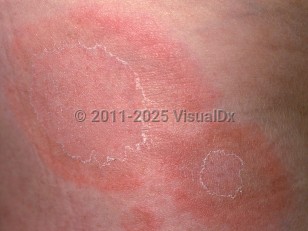Erythema annulare centrifugum in Adult
Alerts and Notices
Important News & Links
Synopsis

EAC can occur at any age but tends to affect young and middle-aged adults. There is no sex or racial predilection. Idiopathic EAC is typically self-limited, and spontaneous resolution is common. However, new lesions may continue to erupt while old lesions resolve. EAC may be asymptomatic or may be accompanied by pruritus.
Cutaneous fungal infection and Helicobacter pylori infection are the most common concomitant infectious diseases. However, other infectious culprits, including ingestion of Penicillium in blue cheese and parasitic, bacterial (eg, Escherichia coli, Pseudomonas), and viral (eg, Epstein-Barr virus, SARS-CoV-2) associations have also been identified. Annual or seasonal reoccurrence of EAC has been reported, although specific triggers in these cases remain unknown.
Certain drugs have been reported to cause EAC-like lesions, including piroxicam, penicillins, chloroquine and hydroxychloroquine, hydrochlorothiazide, spironolactone, cimetidine, phenolphthalein, amitriptyline, hydrochlorothiazide, salicylates, ustekinumab, rituximab, pegylated interferon alpha / ribavirin combination therapy, azacitidine, and antithymocyte globulin.
Reported systemic disease associations include systemic lupus erythematosus, cryoglobulinemia, polychondritis, linear IgA bullous dermatosis, sarcoidosis, hypereosinophilic syndrome, hyperthyroidism, Hashimoto thyroiditis, Graves disease, and pemphigus vulgaris.
EAC in the setting of an underlying malignancy has been described in patients with lymphoproliferative malignancies (polycythemia vera, acute leukemia, chronic lymphocytic leukemia, Hodgkin lymphoma, non-Hodgkin lymphoma, multiple myeloma, myelodysplastic syndrome, histiocytosis), breast cancer, gastrointestinal cancer, lung cancer, prostate cancer, nasopharyngeal cancer, carcinoid tumor of the bronchus, and peritoneal cancer. The eruption may precede the diagnosis of occult malignancy. Malignancy-associated EAC is termed paraneoplastic EAC eruption (PEACE).
Codes
L53.1 – Erythema annulare centrifugum
SNOMEDCT:
399914006 – Erythema annulare centrifugum
Look For
Subscription Required
Diagnostic Pearls
Subscription Required
Differential Diagnosis & Pitfalls

Subscription Required
Best Tests
Subscription Required
Management Pearls
Subscription Required
Therapy
Subscription Required
Drug Reaction Data
Subscription Required
References
Subscription Required
Last Updated:08/06/2025

